| Web
and Book design,
Copyright, Kellscraft Studio 1999-2018 (Return to Web Text-ures) |
 (HOME)
|
|
VII
THE END GAME A work on the game of Go would not be
complete without a
chapter especially devoted to the subject of the end game. On the average a game of Go consists of
about two
hundred and fifty moves, and we might say that about twenty of these
moves
belong to the opening, about one hundred and fifty to the main part of
the
game, and the remaining eighty to the end game. The moves which may be
regarded
as belonging to the end game are those which connect the various groups
of
stones with the margin, and which fill up the space between the
opposing groups
of stones. Of course, there is no sharp distinction between the main
game and
the end game. Long before the main game is finished moves occur which
bear the
characteristics of end game play, and as the game progresses moves of
this kind
become more and more frequent, until at last all of the moves are
strictly part
of the end game. Toward the end of the game it becomes
possible to
calculate the value of a move with greater accuracy than in the middle
of the
game, and in many cases the number of points which may be gained by a
certain
move may be ascertained with absolute accuracy. Therefore, when the
main game
is nearing completion, the players survey the board in order to locate
the most
advantageous end plays; that is to say, positions where they can gain
the
greatest number of "Me." In calculating the value of an end position,
a player must carefully consider whether on its completion he will
retain or
lose the "Sente." It is an advantage to retain the "Sente,"
and it is generally good play to choose an end position where the
"Sente" is retained, in preference to an end position where it is
lost, even if the latter would gain a few more "Me." The player holding the "Sente" would,
therefore, complete in rotation those end positions which allowed him
to retain
it, commencing, of course, with those involving the greatest number of
"Me." He would at last come to a point, however, where it would be
more advantageous to play some end position which gained for him quite
a number
of points, although on its completion the "Sente" would be lost. His
adversary, thereupon gaining the "Sente," would, in turn, play his
series of end positions until it became advantageous for him to
relinquish it.
By this process the value of the contested end positions would become
smaller
and smaller, until at last there would remain only the filling of
isolated,
vacant intersections between the opposing lines, the occupation of
which
results in no advantage for either player. These moves are called
"Dame," as we have already seen. This is the general scheme of an end game,
but, of
course, in actual play there would be many departures therefrom.
Sometimes an
advantage can be gained by making an unsound though dangerous move, in
the hope
that the adversary may make some error in replying thereto. Then again,
in
playing against a player who lacks initiative, it is not so necessary
to
consider the certainty of retaining the "Sente" as when opposed by a
more aggressive adversary. Frequently also the players differ in their
estimate
of the value of the various end positions, and do not, therefore,
respond to
each other's attacks. In this way the possession of the "Sente"
generally changes more frequently during the end game than is logically
necessary. The process of connecting the various
groups with the
edge of the board gives rise to end positions in which there is more or
less
similarity in all games, and most of the illustrations which are now
given are
examples of this class. The end positions which occur in the middle of
the
board may vary so much in every game that it is practically impossible
to give
typical illustrations of them. Of course, in an introductory work of this
character
it is not practicable to give a great many examples of end positions,
and I
have prepared only twelve, which are selected from the work of Inouye
Hoshin,
and which are annotated so that the reasons for the moves may be
understood by
beginners. The number of "Me" gained in each case is stated, and also
whether the "Sente" is lost or retained. To these twelve examples I
have added eight positions from Korschelt's work. Plate 35 (A) The following stones are on the board:
White,
S 15, R 14, P 14, L 17; Black, R 16,
Q 16,
N 15, N 17. If White has the "Sente," he gains eight
"Me," counting together what he wins and Black loses.
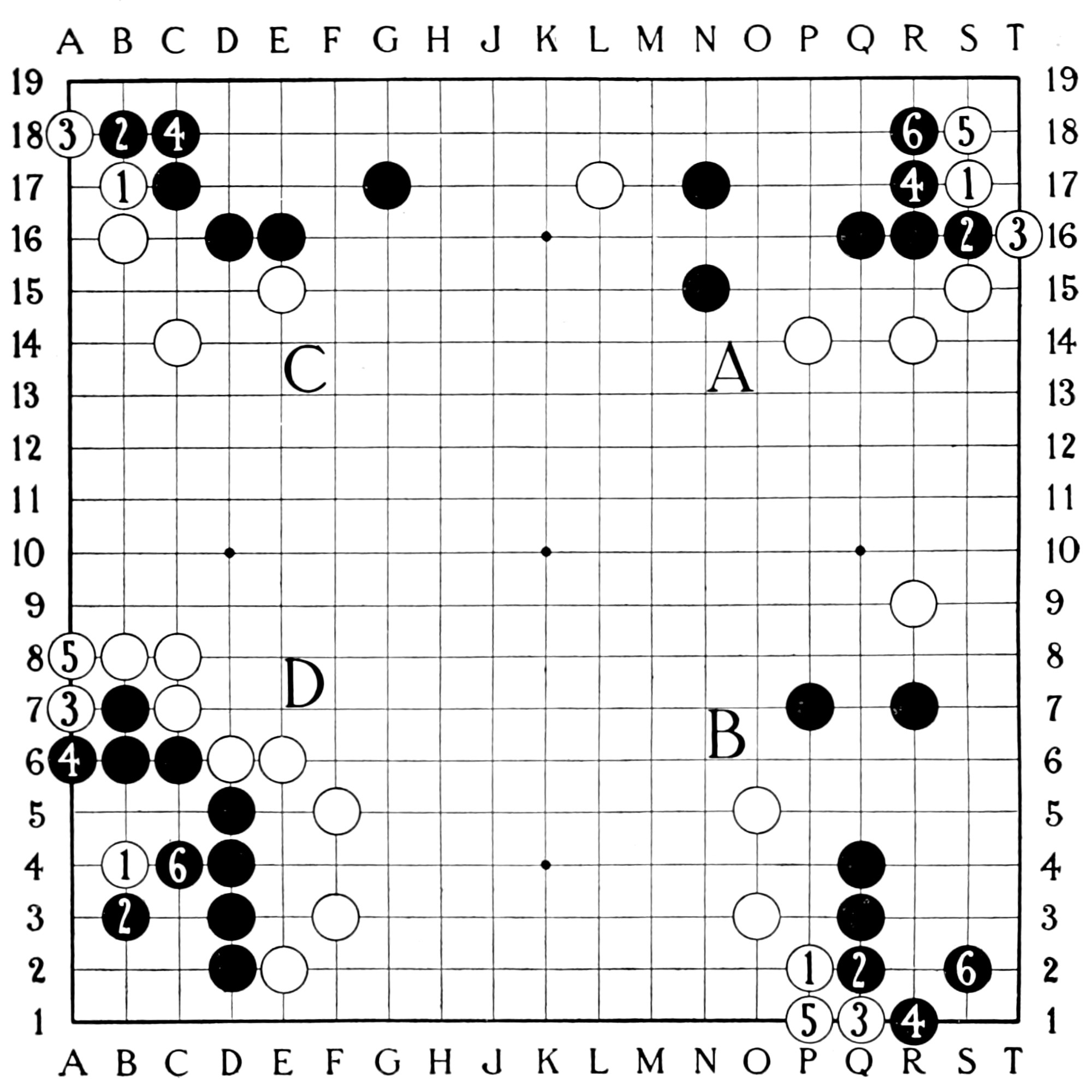 Plate 35
White retains the "Sente." II Plate 35 (B) The following stones are on the board:
White,
R 9, O 5, O 3; Black, P 7, Q 3, Q 4,
R 7. If White has the first move, it makes a
difference of
six "Me."
White retains the "Sente." If Black had had the first move, the play
would have
been as follows:
Plate 35 (C) The following stones are on the board:
White,
B 16, C 14, E 15; Black, C 17, D 16,
E 16,
G 17. If White has the move, it makes a
difference of seven
"Me."
Plate 35 (D) The following stones are on the board:
White,
B 8, C 7, C 8, D 6, E 2, E 6, F 3,
F 5;
Black, B 6, B 7, C 6, D 2, 3, 4, 5. If White has the move, it makes a
difference of four
"Me."
Plate 36 (A) If White has the "Sente," it makes a
difference
of six "Me."
Plate 36 (B) The following stones are on the board:
Black,
M 2, M 3, N 3, N 4, O 4, Q 4, R 4,
S 4;
White, L 3, N 2, O 2, O 3, P 3, R 2,
S 3,
R 6. Black has the "Sente" and gains
nine "Me." 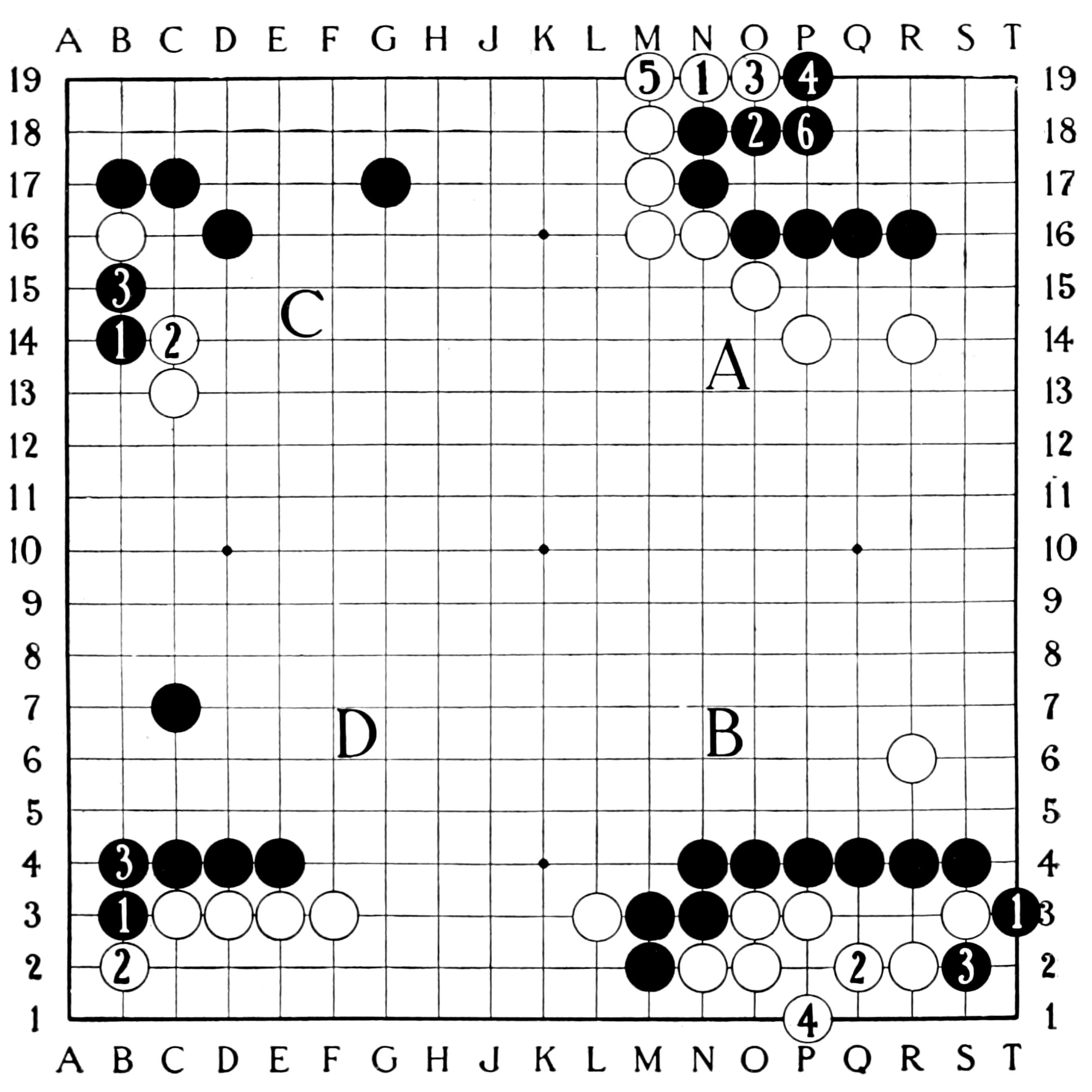 Plate 36
Plate 36 (C) The following stones are on the board:
Black,
B 17, C 17, D 16, G 17; White, B 16,
C 13.
VIII Plate 36 (D) The following stones are on the board:
Black,
C 4, D 4, E 4, C 7; White, C 3, D 3,
E 3,
F 3. Black has the move.
Plate 37 (A) The following stones are on the board:
White,
M 16, N 16, N 18, O 17, P 18, Q 17, 18;
Black,
N 15, O 15, 16, P 16, 17, Q 16, R 12,
R 17.
White has given up the "Sente," but these
moves make a difference in his favor of about fourteen "Me." Plate 37 (B) The following stones are on the board:
White,
M 3, O 3, P 2, Q 3, R 2; Black, N 4,
O 4,
Q 5, R 3, R 4. White has the move.
This move is really "Go te," but if Black
neglects to answer it, White can then jump to T 5. This jump is
called by
a special name "O zaru," or the "big monkey," and would
gain about eight "Me" for White. Plate 37 (C) The following stones are on the board:
White,
C 15, D 15, E 15, 16; Black, C 16, D 16,
E 17,
18, F 16, G 17. White has the move.
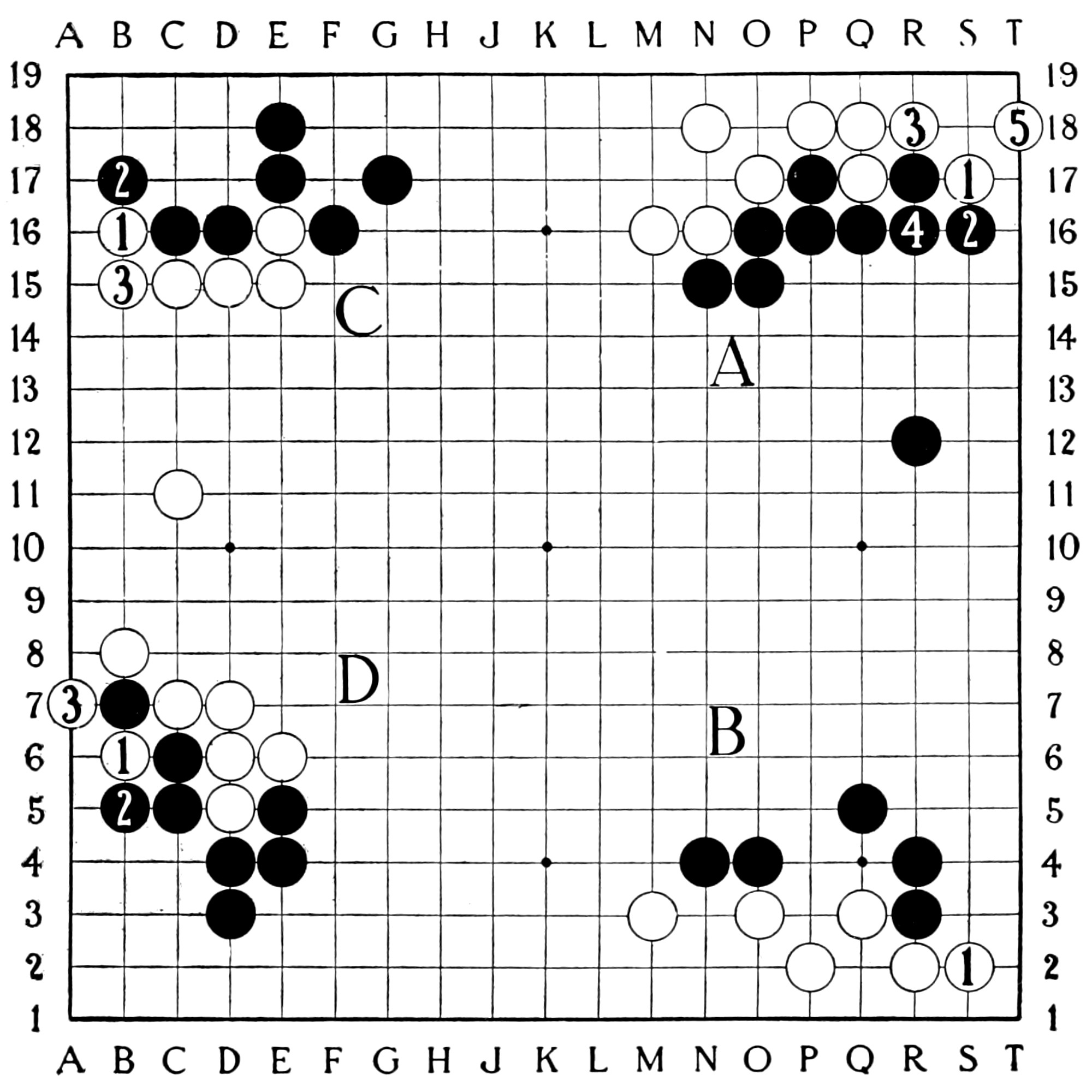 Plate 37 XII Plate 37 (D) The following stones are on the board:
White,
B 8, C 7, 11, D 5, 6, 7, E 6; Black, B 7,
C 5, 6,
D 3, 4, E 4, 5. White has the move.
White has given up the "Sente," but this
method of play gains about fourteen "Me," as it is now no longer
necessary to protect the connection at C 8. We will now insert two plates from
Korschelt's book.
The notes at the foot of the illustrations are his. 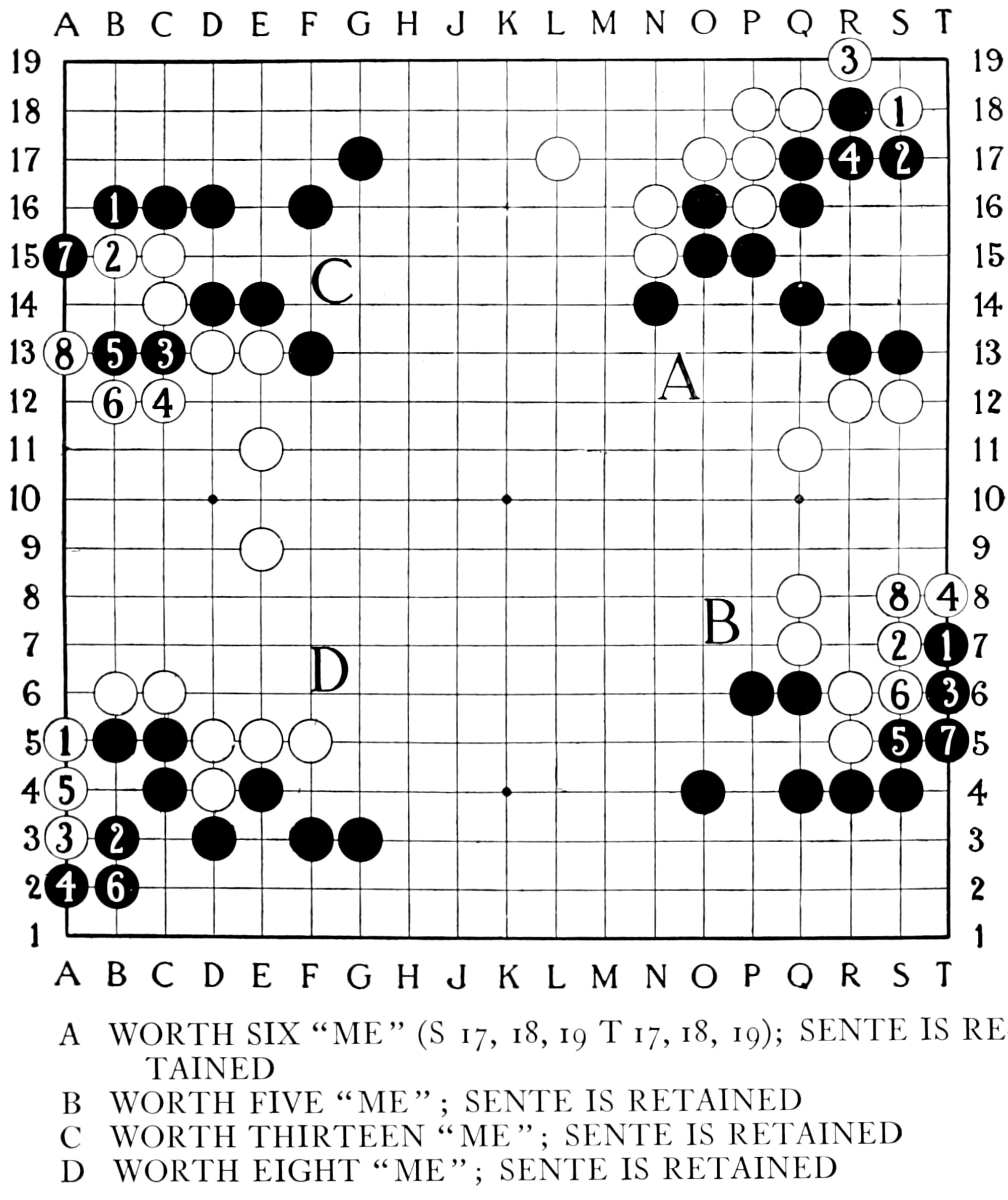 Plate 38 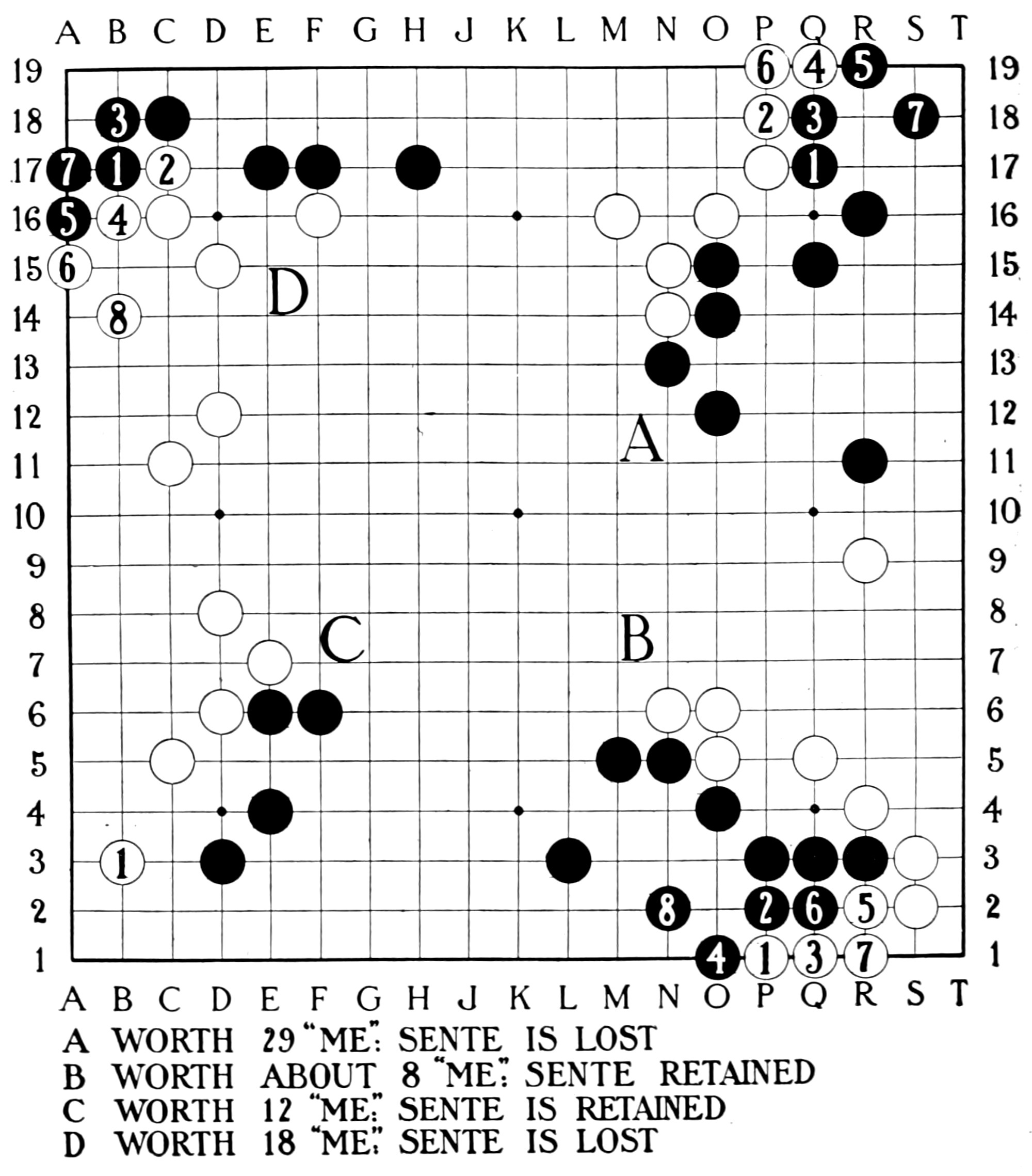 Plate 39 |
|||||||||||||||||||||||||||||||||||||||||||||||||||||||||||||||||||||||||||||||||||||||||||||||